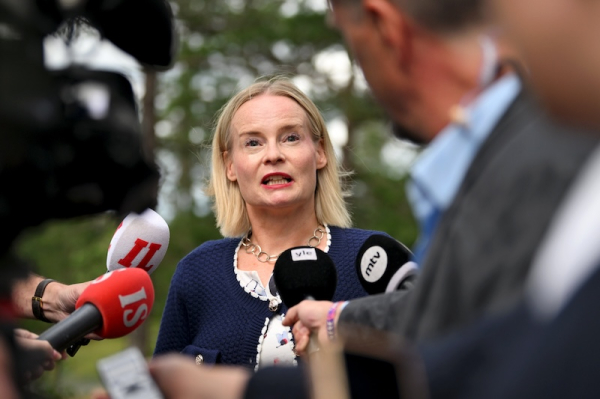Purra confirms business subsidy cuts in €1bn savings push

Finance Minister Riikka Purra (Finns Party) addressed the media at a press conference on the Ministry of Finance’s internal budget negotiations in Moisniemi, Espoo, on 6 August 2025. Photo: Mikko Stig / Lehtikuva
- Next Article Purra pushes for €1 billion budget cuts to be decided this year
Finance Minister Riikka Purra announced on Wednesday that the Finnish government will pursue significant reductions in business subsidies and other secondary expenditures, aiming to generate €1 billion in fiscal savings before the end of the current parliamentary term.
Speaking after internal budget talks held by the Ministry of Finance in Espoo, Purra confirmed that most of the new cuts will be implemented in the 2026 budget. The final proposal will be presented to Parliament after cabinet negotiations in September.
“There is no room left for cuts in social security or healthcare services,” Purra said. “The focus must be on areas where adjustments cause the least harm to citizens’ everyday lives.”
The internal negotiations concluded earlier than expected, with Purra stating that the majority of new reductions had been identified and agreed upon. Development aid and grants to non-governmental organisations were also confirmed as likely targets.
Purra ruled out tax increases, repeating her earlier view that they would weaken consumer purchasing power. “We will not introduce measures that reduce household consumption capacity,” she said.
Business subsidies, long criticised by economists for inefficiency and market distortion, will face scrutiny. According to Economic Affairs Minister Sakari Puisto, changes may include limiting direct grants or converting certain support programmes into temporary schemes. “Support must be more targeted and limited in duration,” Puisto said.
Research institutions have backed this approach. Mika Maliranta, Director of the Labour Institute for Economic Research LABORE, and Essi Eerola, Senior Advisor at the Bank of Finland, identified business subsidies, particularly tax exemptions, as key areas for structural reform. Both noted that many forms of support reduce productivity by protecting underperforming companies and discouraging market entry.
Budget Director Mika Niemelä has previously called for cuts to corporate tax benefits, including the review of reduced electricity tax rates and dividend reliefs. He acknowledged last week that achieving the full €1 billion savings goal will be “extremely challenging” without touching both spending and taxation.
According to Maliranta and Eerola, the long-term costs of preserving inefficient subsidies outweigh short-term political gains. “The consensus among economists is clear, these supports should be phased out,” Maliranta said.
Despite these findings, previous governments have struggled to implement reductions. In spring, only €10 million in business support cuts were agreed, far below initial expectations. This time, Purra signalled stronger commitment.
“The adjustment will happen. It is necessary to meet our fiscal targets,” she said.
Public debt and weak growth have placed additional pressure on the government to act. Finland’s debt-to-GDP ratio continues to rise, with recent forecasts from the Ministry of Finance suggesting the target of stabilisation by 2027 is increasingly unlikely. International ratings agency Fitch recently downgraded Finland’s sovereign credit rating from AA+ to AA–, citing long-term fiscal risks.
Purra acknowledged that future governments will also need to implement further adjustments. Budget officials estimate that an additional €5–8 billion in fiscal consolidation will be needed during the next electoral term.
The government has already adopted savings measures worth around €9 billion. However, the Finnish National Audit Office has reported that only about half of those cuts have been implemented effectively so far.
Demographic trends have added pressure. An ageing population, combined with low productivity growth, continues to increase public expenditure. Economists have called for a more even distribution of fiscal adjustments across age groups, including consideration of pension-related reforms.
“Retirees have largely avoided cuts so far, despite rapidly growing pension costs,” Eerola said. She proposed removing pension accruals linked to academic studies and periods of unemployment as a way to reduce long-term liabilities.
Other areas identified for potential reform include capital gains tax exemptions on primary residences, tax-free employee benefits such as occupational health services, and the dividend tax framework for unlisted companies. Eerola argued these benefits disproportionately assist higher-income earners and reduce taxable income bases.
Despite the scope of the proposed cuts, Purra emphasised that economic fundamentals must be protected. She ruled out reductions to education, research, and innovation funding. “We must not undermine long-term growth potential,” she said.
The Finance Ministry’s official budget proposal will be published on Friday. It will serve as the basis for the government’s September budget session.
HT
- Next Article Purra pushes for €1 billion budget cuts to be decided this year
Source: www.helsinkitimes.fi
